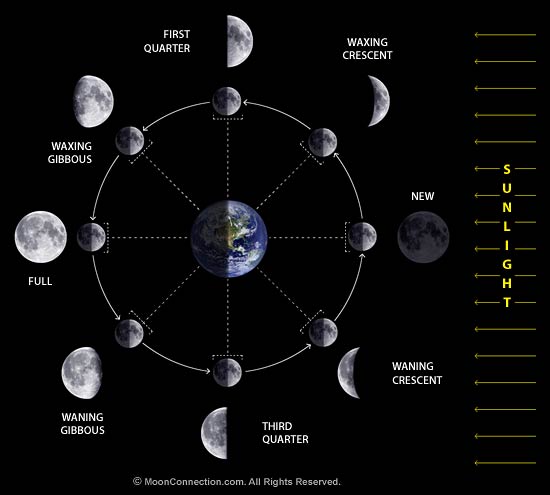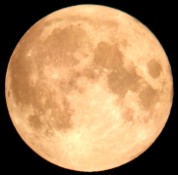Understanding The Moon Phases
Have you ever
wondered what causes the moon phases? We all know that its appearance
changes over time. But why? The good way to understand the phases of
the moon is to examine an earth-moon-sun diagram:

Diagram Explanation
The illustration may look a little complex at first, but it's easy to explain.
Sunlight is shown coming in from the right. The earth, of course, is at the center of the diagram. The moon is shown at 8 key stages during its revolution around the earth. The dotted line from the earth to the moon represents your line of sight when looking at the moon. To help you visualize how the moon would appear at that point in the cycle, you can look at the larger moon image. The moon phase name is shown alongside the image.
One important thing to notice is that exactly one half of the moon is always illuminated by the sun. Of course that is perfectly logical, but you need to visualize it in order to understand the phases. At certain times we see both the sunlit portion and the shadowed portion -- and that creates the various moon phase shapes we are all familiar with. Also note that the shadowed part of the moon is invisible to the naked eye; in the diagram above, it is only shown for clarification purposes.
So the basic explanation is that the lunar phases are created by changing angles (relative positions) of the earth, the moon and the sun, as the moon orbits the earth.
Moon Phases Simplified
It's probably easiest to understand the moon cycle in this order: new moon and full moon, first quarter and third quarter, and the phases in between.
As shown in the above diagram, the new moon occurs when the moon is positioned between the earth and sun. The three objects are in approximate alignment (why "approximate" is explained below). The entire illuminated portion of the moon is on the back side of the moon, the half that we cannot see.
At a full moon, the earth, moon, and sun are in approximate alignment, just as the new moon, but the moon is on the opposite side of the earth, so the entire sunlit part of the moon is facing us. The shadowed portion is entirely hidden from view.
The first quarter and third quarter moons (both often called a "half moon"), happen when the moon is at a 90 degree angle with respect to the earth and sun. So we are seeing exactly half of the moon illuminated and half in shadow.
Once you understand those four key moon phases, the phases between should be fairly easy to visualize, as the illuminated portion gradually transitions between them.
Moon phases are very interesting to learn about because astronomy can really impact your life like your hobbies, career, and more. Owning a telescope is a great thing so you can observe the beautiful night time sky. Astronomy is a great job because you can always learn and discover new amazing things. The great thing is that nobody will ever find out every single thing in space. Once you think about it you will realize that space is very amazing in many amazing ways. A lot of people love space and I bet that you will too. Space is a spectacular place to explore and learn about.
The Moon's Orbit



Although the synodic and sidereal periods are exact numbers, the moon phase can't be precisely calculated by simple division of days because the moon's motion (orbital speed and position) is affected and perturbed by various forces of different strengths. Hence, complex equations are used to determine the exact position and phase of the moon at any given point in time.
Also, looking at the diagram (and imagining it to scale), you may have wondered why, at a new moon, the moon doesn't block the sun, and at a full moon, why the earth doesn't block sunlight from reaching the moon. The reason is because the moon's orbit about the earth is about 5 degrees off from the earth-sun orbital plane.
However, at special times during the year, the earth, moon, and sun do in fact "line up". When the moon blocks the sun or a part of it, it's called a solar eclipse, and it can only happen during the new moon phase. When the earth casts a shadow on the moon, it's called a lunar eclipse, and can only happen during the full moon phase. Roughly 4 to 7 eclipses happen in any given year, but most of them minor or "partial" eclipses. Major lunar or solar eclipses are relatively uncommon.
